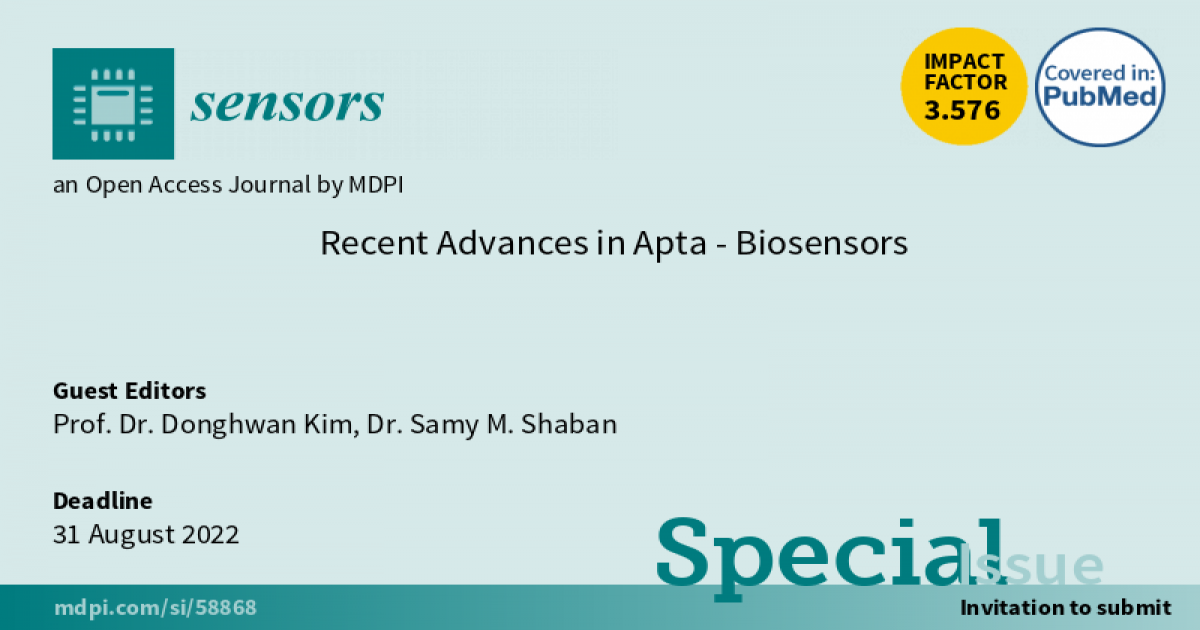Recent Advances in Apta-Biosensors
A special issue of Sensors (ISSN 1424-8220). This special issue belongs to the section "Biosensors".
Deadline for manuscript submissions: closed (31 August 2022) | Viewed by 12753

Special Issue Editors
Interests: sensors; optical materials; nanophotonics; nanotechnology
Interests: chemical sensor; bio-sensor; nanotechnology; surfactant technology; corrosion; catalysis
Special Issues, Collections and Topics in MDPI journals
Special Issue Information
Dear colleagues,
The amazing and rapid scientific development in nanotechnology has made a breakthrough in the field of chemical and biological sensors. Sensor development is considered to be one of the most important aspects of scientific progress because of its impact on preserving the environment and human health, in addition to the economic aspect. The sensors can be used to detect pollutants, toxic heavy metals, or even biomarkers for many infectious and epidemic diseases.
The development of biosensor technology has attracted great attention as a method of analysis and diagnosis. It must meet points of care requirements such as being a fast, simple, selective, and low-cost method of analysis and diagnosis. Nanotechnology provides great progress in the field of sensors due to its higher surface area to volume ratio, optical properties, biocompatibility, and ability to manifest biological signaling and transduction mechanisms.
The aim of this Special Issue is to collect recent progress and development in biosensor technology describing biomarkers and toxic materials assays. The Special Issue welcomes papers, communications, and reports covering topics that include but are not limited to the following:
Apta-Biosensor progress
Chemical sensor development
Point-of-care testing
Optical biosensor
Biomarkers assay
Nanotechnology
Bio-sensor applications
Solid-based biosensor
Fluorometric biosensor
Prof. Dr. Donghwan Kim
Dr. Samy M. Shaban
Guest Editors
Manuscript Submission Information
Manuscripts should be submitted online at www.mdpi.com by registering and logging in to this website. Once you are registered, click here to go to the submission form. Manuscripts can be submitted until the deadline. All submissions that pass pre-check are peer-reviewed. Accepted papers will be published continuously in the journal (as soon as accepted) and will be listed together on the special issue website. Research articles, review articles as well as short communications are invited. For planned papers, a title and short abstract (about 100 words) can be sent to the Editorial Office for announcement on this website.
Submitted manuscripts should not have been published previously, nor be under consideration for publication elsewhere (except conference proceedings papers). All manuscripts are thoroughly refereed through a single-blind peer-review process. A guide for authors and other relevant information for submission of manuscripts is available on the Instructions for Authors page. Sensors is an international peer-reviewed open access semimonthly journal published by MDPI.
Please visit the Instructions for Authors page before submitting a manuscript. The Article Processing Charge (APC) for publication in this open access journal is 2600 CHF (Swiss Francs). Submitted papers should be well formatted and use good English. Authors may use MDPI's English editing service prior to publication or during author revisions.
Keywords
- Apta-Biosensor progress
- Chemical sensor development
- Point-of-care testing
- Optical biosensor
- Biomarkers assay
- Nanotechnology
- Bio-sensor applications
- Solid-based biosensor
- Fluorometric biosensor







